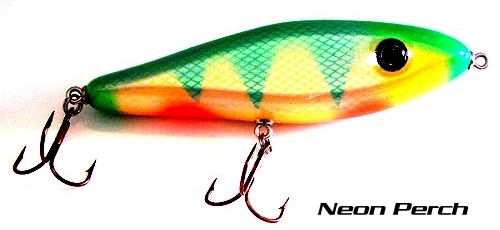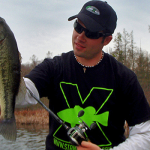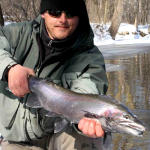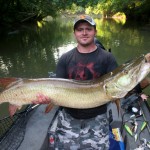By Cory Allen
In the musky waters surrounding Rock Island State Park in middle Tennessee, I not only get to fish southern dragons year around, but the system itself has several interconnected but distinctive fisheries within just a short trailer ride between one another, but virtually impossible to reach via water. On any given trip, we can alternate between midday trolling to night time kayak fishing, or shore fishing select areas only to run up a remote stretch of fertile river. In the winter, with generally higher flows ( often times the weather is, albeit, just short of menopausal), we can safely and effectively fish miles of water, from the river to the lake, in my Tuffy Ltd. Granted my rig sports a hydraulic jack plate for the shallowest portions, but it is rarely needed in winter flows.
Despite there being open water year around, even during durations of sub-zero temperatures, the water down in middle Tennessee on the Rock Island system does normally get very cold. We don’t have hot-water discharge like Melton Hill, so there is not quite the congregation of muskellunge into a small area here as there is on that system, but still, pockets of fish will be evident in concentrated numbers, especially on the reservoir. As in so many cases, finding the warmest water and learning to work the adjacent structure situations is paramount. Often times, these areas will also be holding massive pods of threadfin shad and redhorse sucker, the two major food groups of Rock Island musky. Between the pelagic balls of threadfins and the more bottom-oriented but larger(3-5 lb) redhorse, our fish maintain a much larger than normal girth throughout the year, but become epically proportioned after Black Friday, especially on the reservoir.
 As stated before, on the particular system I fish, in the winter finding the areas that are markedly warmer than surrounding sections is a big step in the right direction. A lot of times these areas will be found where there is an increase in current and darker water, which ironically are also factors in and of themselves that increase your odds of finding active fish.
As stated before, on the particular system I fish, in the winter finding the areas that are markedly warmer than surrounding sections is a big step in the right direction. A lot of times these areas will be found where there is an increase in current and darker water, which ironically are also factors in and of themselves that increase your odds of finding active fish.
Once you find areas with all the ingredients for a musky smorgasbord, as in virtually every situation, presentation is the other half of the equation. Sometimes, on the right days and musky horoscope predictions I.e. moon phase charts, it really can be as easy as throwing a bloody sirloin into a shark tank, but most days you have to dial in a bit before you really tap the potential of these areas.
On any given winter trip, we already know the general areas that will be holding fish at this time of year, but our game may change throughout the day. Due to the generally steep banks of Great Falls, and submerged timber, we normally opt for deeper cranks in casting and twitching applications, the logic being that the steeper dive curve more appropriately tracks the rapidly descending topography from the bank, and thus putting the bait into the strike zone longer. Ernies, Kraves, and Triple-Ds make up a big part of the reservoir arsenal. The near vertical dive of these baits, along with increased resistance, makes them invaluable as winter twitch baits during the coldest times of year, when even the warmer sections can drop into the 30s. Sometimes the takes are slow and almost seem like the fish have taken their dentures out, there are other times this approach can lead to cannonball force strikes more reminiscent of the giant stripers just down the road. The best thing about these baits is that they are also the best baits to be slow-trolled along deeper 12-20 foot feeder creek breaklines. Call me pragmatic, but I love baits that “cross-train” well.

One of the best untapped patterns on our waters, both river and lake, is the use of the glide bait. Combining the burst of sudden dynamic speed and direction with an immediate shift to a slow halt and tantalizing hover allows them to garner the attention of both actively feeding and more neutral fish. In my honest opinion, there are three glide baits that are best suited to the situation. Sadly, one of them, the Dunwright Dancer, is no longer in production, but may be the most versatile of the three. It has near perfect balance of glide length and fall rate, allowing for use at multiple speeds and depths, yet the design of the bait gives the bait a bit of a loose swagger to its step, which lends it to be creatively fished. One of the neatest things is that with a little practice, random darts, jinks, and weaves can be incorporated into the retrieve, a huge factor in turning window-shoppers into satisfied customers.

Dunwright Dancer
The next glide bait shares a lot of the same traits of the Dunwright, but with a bit more rigid consistency. Granted, this trait has made the Hellhound the mainstay it is today, and it is still one of the top 5 tools I would have with me to survive a post-Apocalypse scenario, simply for obtaining sustenance, but it lacks some of the artistic expression that the Dunwright Dancer can allow. The two baits are very similar in action and handling…just consider it the difference between a mass-produced quality horn and a hand-crafted instrument made by a true artisan. The first model makes a lot of players sound great in their own right, but the right hand-made horn in the hands of the right artist is what makes a Dizzy Gillespie or a Clifford Brown. One trick that works well on the Hellhound as well as the Dancer is giving a short, violent upward strike on the retrieve. It causes the glider to turn to the side and quickly nose dive a foot or two. Ever seen a gull in mid-flight suddenly dive to the side to nab a fish? It looks exactly the same, and it can be deadly for drawing out fish and even more so if you have a following fish that is still having commitment issues. I didn’t really recognize the value of the last winter glider until fishing.

Make no mistake…despite limited new recruitment, very low length limits, poaching, and minimal stocking; multiple fish days are not uncommon. My boat has personally seen up to 9 fish days on the lake, with several fish in the mid-high 40’s. On one of our best winter trips, fishing for only 3.5 hours, 3 high 30 inchers, a 45″, and a massive 49.5″ fish with 25″ girth was landed, with a couple more being lost to poor hook sets, and make no mistake, there is a real shot at a mega fauna muskellunge here. Tom Kelly, a friend and angler from Dalton, Georgia landed and released a 54″ musky from the system in 2007. Do I believe that was the biggest dragon haunting these depths? Not hardly…and that is no discredit to Tom’s mastadonian musky…there is just the potential for fish, I personally believe, into the high-50s.
Cory Allen, 27, of Cookeville, Tennessee is the founder and lead guide of Stone’s Throw Adventures. Allen’s team of guides fish the waters throughout Tennessee and Kentucky, guiding on a year-round basis, and offer their clients a wide variety of boat and wading trips for all species of gamefish. http://www.stonesthrowadventures.com/














